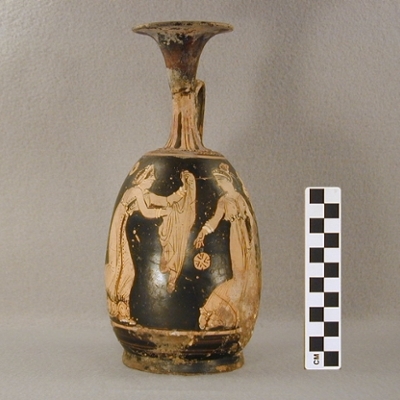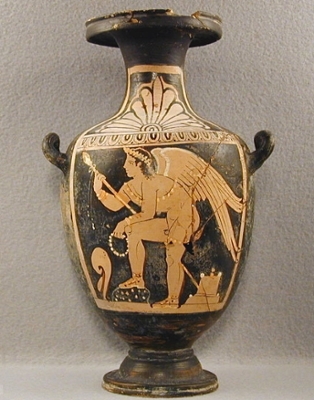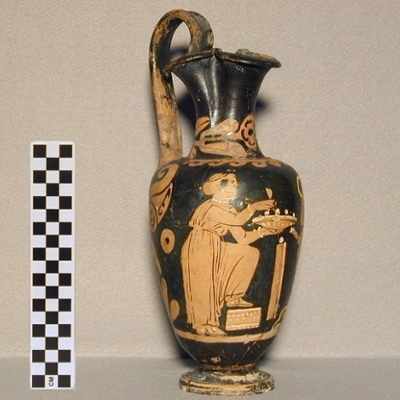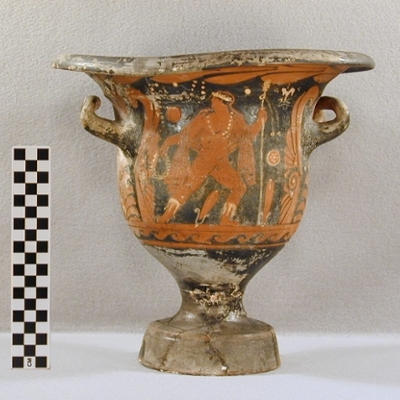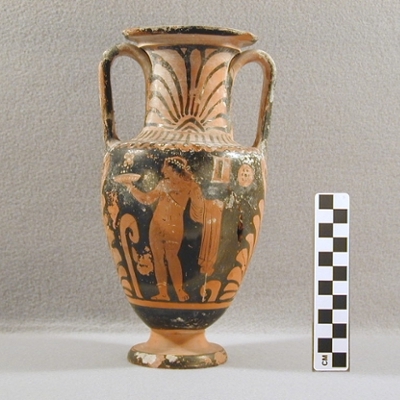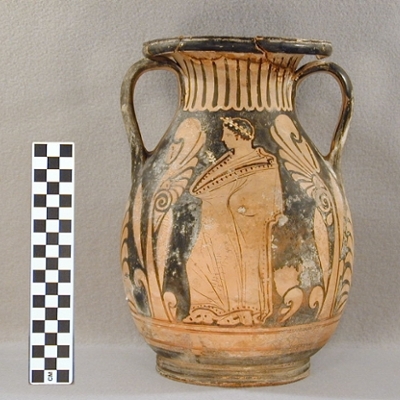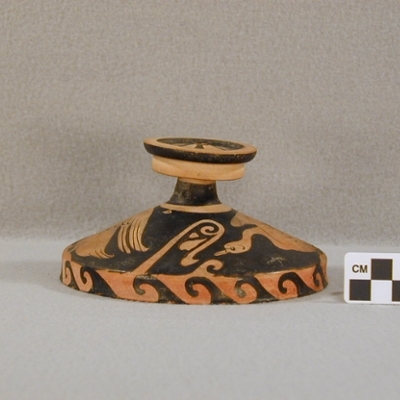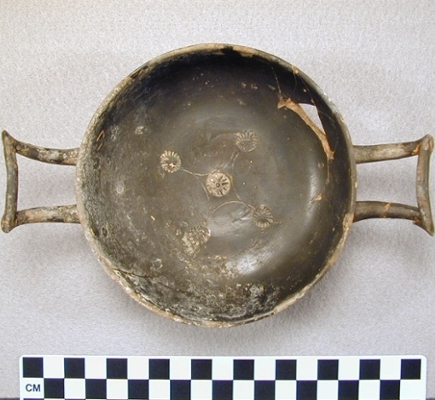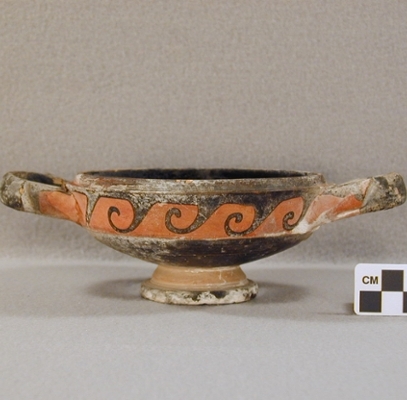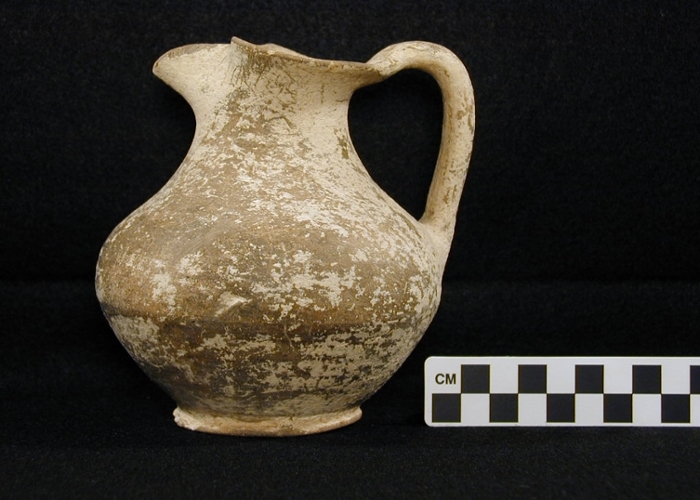Please click on thumbnails for more information. Cataloging and visual analysis by Margaret Bowman '84 as part of her honors thesis in the Department of Classical Studies.
South Italian Pottery
-
Red-Figure Squat Lekythos
1900.2562.22
Campanian, attributed to the Whiteface Painter (AV I)
ca. 360-330 BCE
24.3 cm high x 11.1 cm greatest diameterSquat lekythoi were commonly used as oil containers. This vase features a domestic scene of a woman and her maid. In this image, the maid can be seen running to hand her mistress a cloak.
Read BioRed-figure pottery was produced via a complex series of firings that result in painted areas appearing black, while unpainted areas retain the reddish color of the clay. The "paint" was actually a clay slip that chemically bonded with the surface of the vessel during the firing process, resulting in a durable decorated finish. Colors like white, red, and grey could all be produced with such slips, and were used to enhance the color of the clay or add detail to the decoration. Other colors, added after firing, are less durable and are thus rarely seen intact on archaeological finds. -
Red-Figure Hydria
1900.2562.17
Paestan, attributed to the Boston Orestes Painter
ca. 325-310 BCE
25.9 cm high x 14.0 cm greatest diameterThe hydria was traditionally used as a water jar, but the relatively small size and high quality of this vessel indicate that it was more likely a decorative, rather than a functional, object. It depicts Eros as a young man, holding a spear and wreath, with his foot resting on a spotted rock. A small altar appears behind him.
-
Red-Figure Oinochoe
1900.2562.16
Campanian, attributed to the Capua Painter
ca. 360-330 BCE
27.6 cm high x 13.0 cm greatest diameterOinochoai - single-handled jugs - come in various sizes and mouth shapes, and were used for pouring liquids, including wine. The scene on this trefoil-mouthed vessel features a young satyr (pictured) and a maenad making offerings, presumably to Dionysus, god of wine. Such Dionysian scenes are common on South Italian pottery.
-
Red-Figure Bell Krater
1900.2562.24
Paestan, attributed to the Painter of Naples 1778
ca. 315-285 BCE
28.0 cm high x 17.2 cm greatest diameterThe bell-krater was a common vase shape produced in South Italian workshops. It was used for mixing wine with water. This vessel depicts Dionysus, god of wine, holding a wreath and a thrysus. The latter is a fennel staff, topped by a pinecone and often wound with ivy or other leaves, that is strongly associated with Dionysus and his followers.
-
Red-Figure Neck Amphora
1900.2562.13
Campanian, attributed to the Whiteface Painter (AV I)
ca. 360-330 BCE
25.3 cm high x 12.8 cm greatest diameterNeck amphorae were commonly used as storage jars for all types of liquids. This amphora features a scene of a running woman and a standing youth. The latter, pictured here, is holding a phiale - a shallow bowl used for making offerings of wine or oil. The artist may have intended for the youth to be leaning on a pillar, as evidenced by his stance and the presence of a white line extending down from the drapery over his left arm.
-
Red-Figure Pelike
1900.2562.25
Paestan, attributed to Python
ca. 350-325 BCE
28.2cm high x 20.2 cm greatest diameterThe pelike, like the amphora, was a storage vessel used for liquids. Two youths are pictured on this vase; the one seen here is draped in a himation, or cloak. The cloak's embattled border pattern and thinly-painted folds help distinguish Python's work from that of his mentor, Asteas.
-
Red-Figure Lekanis Lid
1900.2562.10
Campanian, attributed to the VPH (Vienna, Philadelphia, and Hamm) Painter
ca. 350-325 BCE
6.7 cm high x 14.0 cm greatest diameterThis vessel lid depicts two swans. It would have been paired with a flat, handled bowl similar to object 1900.2562.26 in Wesleyan's collection. Such vessels were used for holding trinkets, cosmetics, and food. They were given as bridal gifts and occasionally used as funerary offerings.
-
Black-Glazed Stemless Cup
1900.2562.32
Protocampanian
ca. 350-300 BCE
4.4 cm high x 11.6 cm greatest diameterStemless cups were a popular shape of drinking vessel in the 5th and 4th centuries BCE. This cup features a central impressed (stamped) floral design, surrounded by four stamped palmettes connected by incised lines. This standard 4th-century design appears on two other vases in Wesleyan's collection.
-
Black-Glazed Lekanis
1900.2562.26
Protocampanian
ca. 350-300 BCE
6.5 cm high x 13.5 cm greatest diameterThis vessel would have originally had a lid, similar in shape to object 1900.2562.10 in Wesleyan's collection (the two pieces are not an actual pair). Such vessels were used for holding trinkets, cosmetics, and food.They were given as bridal gifts and occasionally used as funerary offerings. The wave border is a motif commonly seen on the bodies of lekanides, which are often plainly decorated compared with their ornate lids.The white patches in the image are mineral deposits that can accumulate on pottery buried in - or in contact with - the ground. They are the result of water and minerals in the soil reacting with the clay.
-
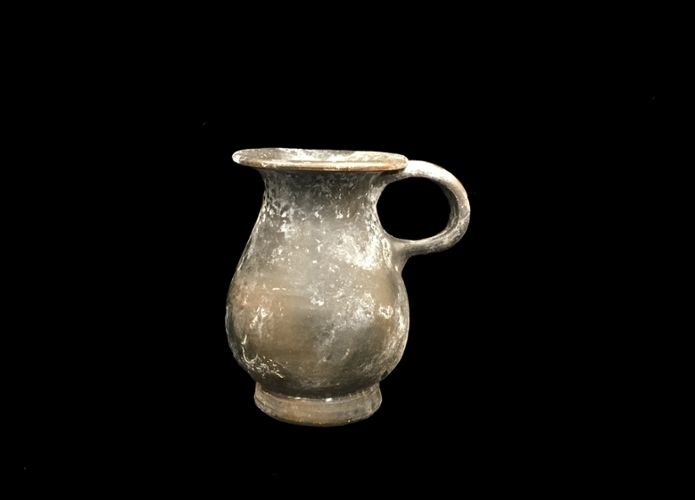
Black-Glazed Olpe
1900.2562.20
Protocampanian
ca. 350-300 BCE
7.8 cm high x 5.6 cm greatest diameterThis small vessel may have been used as a liquid measure.
-
Black-Glazed Lekythos
1900.2562.40
Protocampanian
ca. 350-300 BCE
12.6 cm high x 9.4 cm greatest diameterThis type of lekythos was probably used domestically for table oil before it was used for funerary purposes. The red and brownish-looking patches are the result of mistakes in the original firing process.
-
Domestic Ware Oinochoe (Chous)
1900.2562.31
Protocampanian
ca. 350-300 BCE
13.3 cm high x 12.2 cm greatest diameterThis simple jug was likely used domestically as a pouring vessel, and perhaps as an informal liquid measure, before ending up in a funerary context. It is made of a poorer quality clay than other vessels in the collection, is not fully glazed, and exhibits numerous signs of use.
Read BioOriginally it was also covered in mineral deposits, which were removed in 2003. Cleaning was performed as part of a joint project between Cathy Pyenson '05, conservator Catherine Sease of the Yale Peabody Museum of Natural History, and collections staff.
